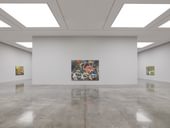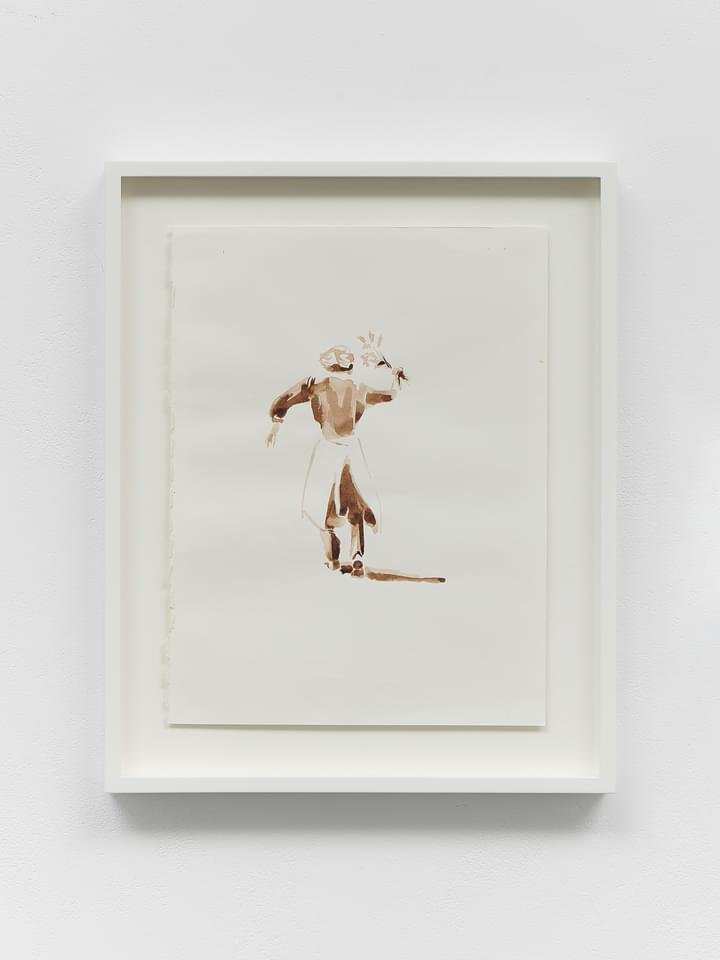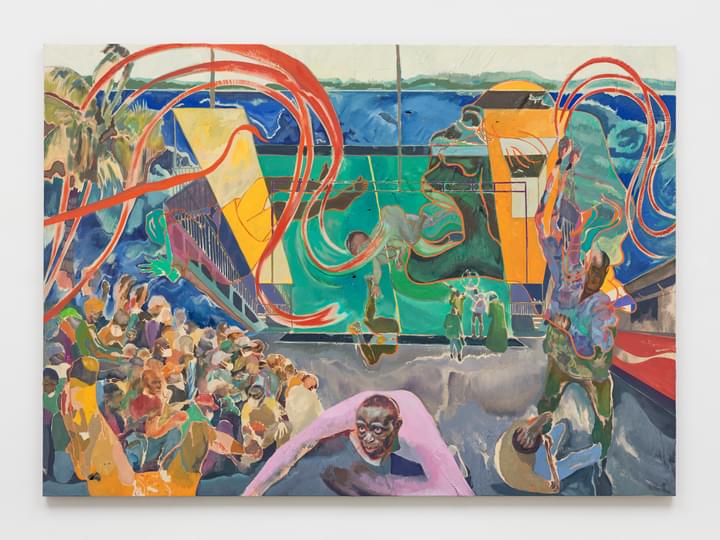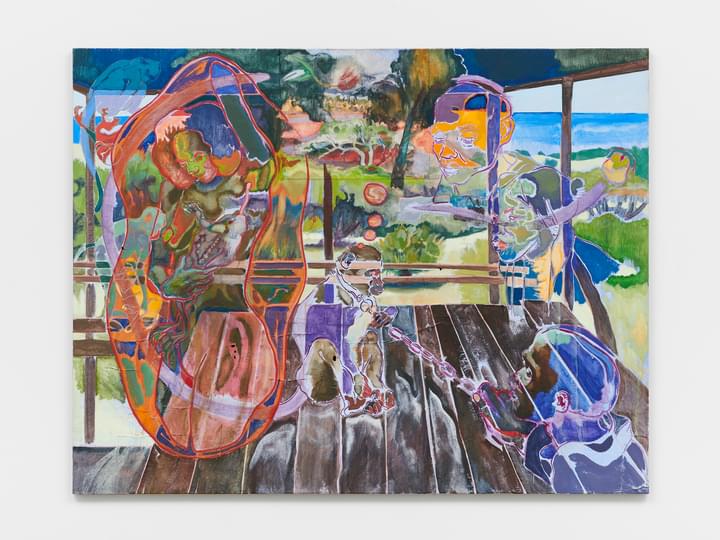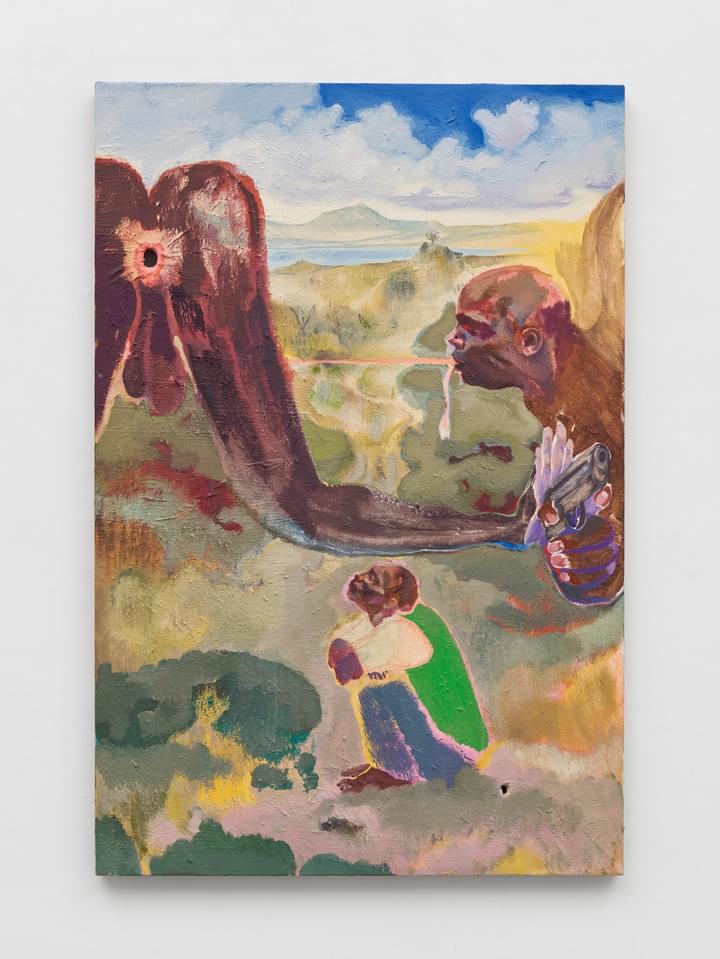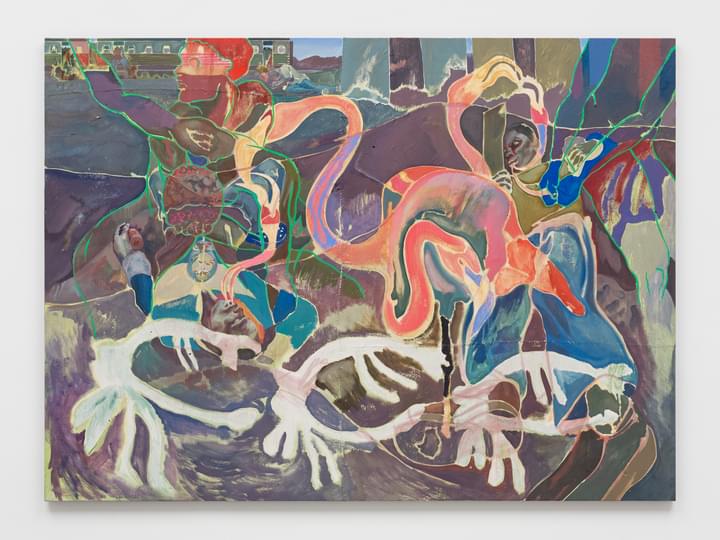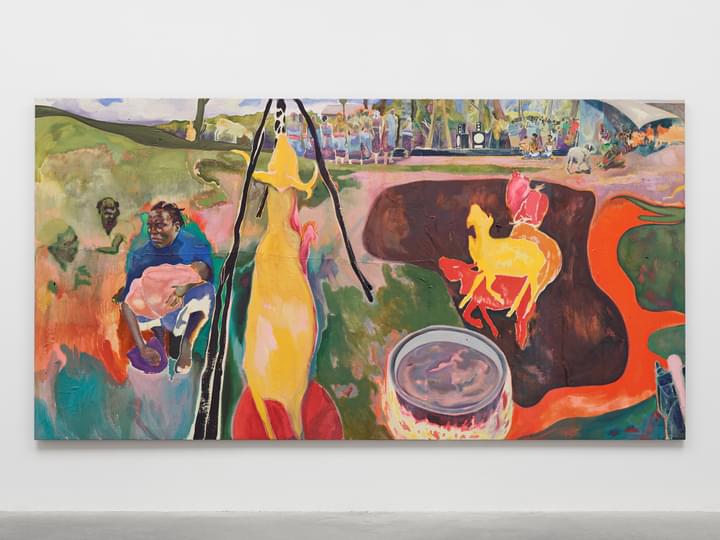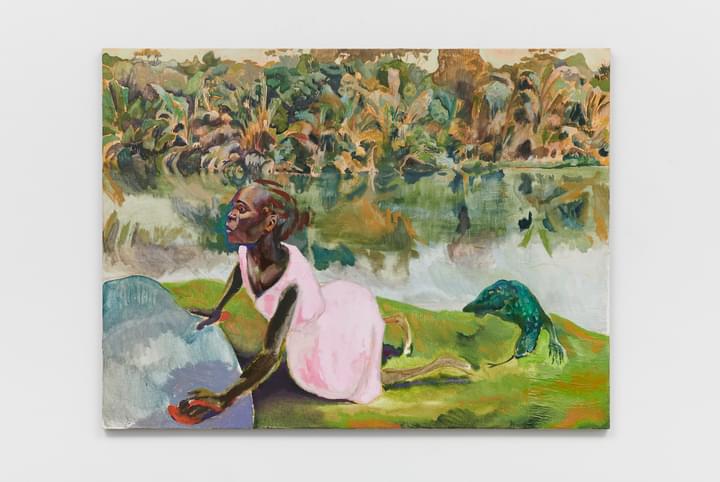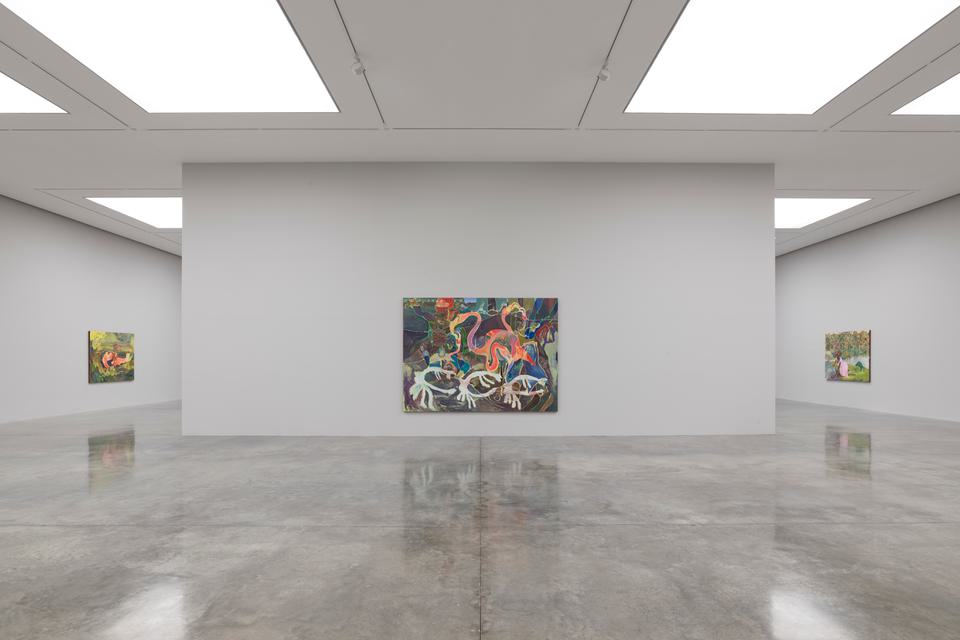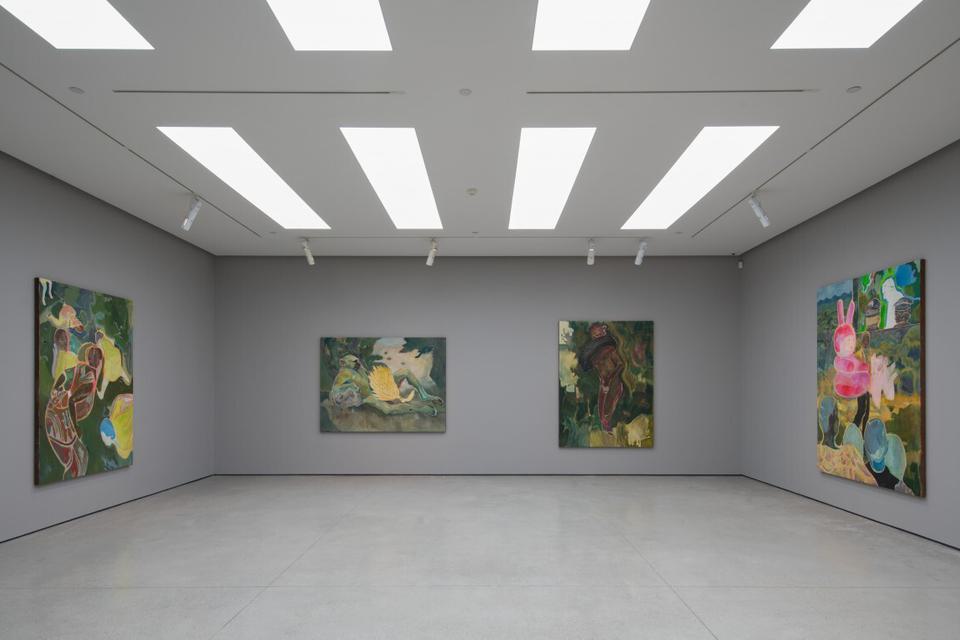Living and working between Indonesia and Nairobi, Armitage paints with oil on Lubugo, a traditional bark cloth from Uganda, which is beaten over a period of days creating a natural material which when stretched taut has occasional holes and coarse indents. As noted by the artist, the use of Lubugo is at once an attempt to locate and destabilise the subject of his paintings.
Applying the paint in layers, Armitage scrapes, revises and repaints his compositions. The visual iconography of East Africa lies at the heart of his practice: its urban and rural landscape, colonial and modern vernacular architecture, advertising hoardings, lush vegetation and varied animal life. Undermining this rich colour palette and dream-like imagery, however, is a quiet exposition of Kenya’s sometimes harsh reality: its politics, social inequalities, violence and extreme disparities in wealth. In turn, Armitage reflects on the more absurd aspects of the everyday, commenting on both society and the surrounding natural environment – evoked with a lyrical and phantasmagorical vision.
Armitage claims that ‘Painting is a way of thinking through something, trying to understand an experience or an event a little better and trying to communicate something of the problem to others’. Inspired by the 2017 Kenyan General Elections, Armitage centred a series of eight paintings and ink drawings around his own experience at an opposition rally situated in Uhuru Park with a local press team. Amongst the crowds, the artist bears witness to politics at play as he recalls a number of carnivalesque revellers dressed up in outfits with wigs, masks and slings at the ready to rouse further attention. Those same characters were reported in the news running through teargas throwing stones at the police force that replied with live rounds, as further political rallies turned to protest and eventual violence.
More recently, Armitage has drawn his subject matter from a wide range of sources, reimagined with a sensibility that might be likened to magic realism. Whether painted outdoors in Kenya, in Armitage’s London studio, or in his new home of Indonesia, his landscape, or urban vistas, collide timescales – compressing past and present, the real and imagined. Multiple viewpoints, superimpositions of outlines and figures, saturated and vaporous swathes of vivid colour and passages of translucent wash create a dense pictorial language in which materiality and form effortlessly meld, where subject and subtext have equal status and thematic power.
Recent works inspired by Ngũgĩ wa Thiong’o’s acclaimed novel The Perfect Nine (first published in 2018) include a 2022 painting of the same name, in which Armitage depicts Warigia, the tenth daughter of the East African Gīkuūyū people’s founding father who is born severely disabled yet becomes the unlikely heroine of the story. Warigia (2022), portrays her as she realises she is cured of her disabilities – emerging from the lake as she pulls her body upright using a boulder for support.
Conceived on the scale of a classical history painting, Dandora (Xala, Musicians) (2022) takes its point of departure from the film Xala (1975) by Ousmane Sembène. Featuring a gathering of nomadic musicians, trash pickers and livestock that roam a landscape of smouldering rubbish heaps, it reimagines this neglected space. Linking the abject with the phantasmagorical, this is a panoramic vision of Dandora, Nairobi’s principal rubbish dump, where foragers and animals habitually assemble. Three Boys at Dawn (2022) considers similarly urban subject matter – street boys sniffing glue for a temporary high. Here, flowing, fused forms suggest the illusory or magical nature of a dream, in which flamingos transfigure from plumes of smoke and meander out of the boys’ exhaling mouths.
Exploring individual subjects within the throng of communal assembly, Armitage’s painting Head of Koitalel (2021) confronts the violence of Kenya’s colonial legacy. In this work Armitage exhumes the story of Koitalel Arap Samoei (1860−1905), an Orkoiyot and spiritual and political leader of the Kenyan Nandi people who led the revolt against the British and was subsequently tricked and beheaded. In sympathy with the painting’s tragic subject, the stitching visible in the Lubugo cloth provides a compositional dynamic that demarcates areas of colour and dramatically bifurcates Koitalel’s severed, lifeless head. Curfew (Likoni, March 27, 2020) (2022) references more recent political upheaval, using reversed perspectives, overlaid imagery, brilliant colour and dense crowd scenes to convey the urgent, chaotic nature of life during the Covid lockdown of 2020 and 2021. By contrast, in Holding Cell (2021) violence is inferred, the subtext of an image based on the accounts of overcrowding in Nairobi police cells. Armitage’s paintings describe the contradictions of a post-colonial modernity where matters of life and death are always present.
As Catherine Lampert describes: ‘His approach is synthetic but various in terms of composition; sometimes shapes flow, occasionally images are cut and pasted, he experiments with florid colour and sinuous line, and eventually the elements click into place… This instability exists in part because the stories that inform Armitage’s paintings have been filtered by inherently unreliable voices.’
Using a flattened perspective Armitage’s figuration evolves into passages of pure abstraction, and then back again seamlessly within one painting creating works that are both romantic and synchronous, offering up various narrative threads, only to then unravel them like a resonant myth or legend.
Michael Armitage was born in 1984 in Nairobi, Kenya and lives and works between Indonesia and Nairobi. He received his BA in Fine Art from the Slade School of Fine Art, London (2007) and has a Postgraduate Diploma from the Royal Academy Schools, London (2010). In 2022, the Royal Academy of Arts, London, elected him a Royal Academician in the category of painting.
Armitage is the founder of the Nairobi Contemporary Art Institute, a non-profit platform established in 2021.
Solo exhibitions include: Kunsthaus Bregenz, Austria (2023); White Cube Bermondsey, London (2022); Kunsthalle Basel (2022); Calcografía Nacional, Real Academia de Bellas Artes de San Fernando, Madrid (2022); Ny Carlsberg Glyptotek, Copenhagen (2021); Royal Academy, London (2021); Haus der Kunst, Munich (2020); The Norval Foundation, Cape Town (2020); Projects 110, Studio Museum in collaboration and at MoMA, New York, Museum of Contemporary Art Sydney (2019); Fondazione Sandretto Re Rebaudengo, Turin (2019); South London Gallery (2017); Turner Contemporary, Margate, UK (2017); White Cube, Hong Kong (2017); Berkeley Art Museum and Pacific Film Archive, San Francisco (2016); White Cube, London (2015); and Royal Academy Schools Studios, London (2010).
Selected group exhibitions include Fondation Beyeler, Switzerland (2024); Fondation Carmignac, Hyères, France (2024); Astrup Fearnley Museum of Modern Art, Oslo (2023); Tate Modern, London (2023); Zeitz MOCAA, Cape Town (2022); Galerie Rudolfinum, Prague (2022); Tate Britain, London (2022); Royal Academy Summer Exhibition, London (2022); The Drawing Center, New York (2022); British Art Show 9, UK (2021-2022); Palais de Tokyo, Paris (2021); Royal Academy Summer Exhibition, London (2021); Pallant House Gallery, Chichester, UK (2021); Diversity United, Flughafen Tempelhof, Berlin (2021); Drawing Biennial, Drawing Room, London (2021); The Warehouse, Dallas (2020); Whitechapel Gallery, London (2020); 58th Venice Biennale (2019); Nasher Museum of Art, Durham, North Carolina (2018); Prospect.4, New Orleans (2017); Scottish National Gallery of Modern Art, Edinburgh (2017); HOME, Manchester, UK (2016); Yuan Art Museum, Beijing (2015); 13th Biennale de Lyon, France (2015); Palazzo Capris, Turin, Italy (2015); South London Gallery (2014); and Drawing Room, London (2013).


